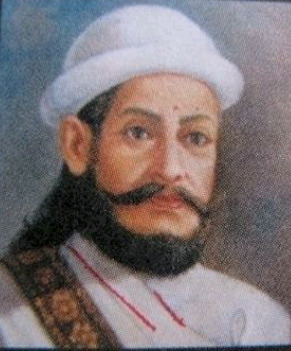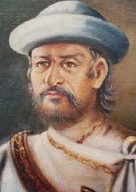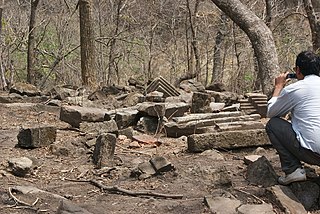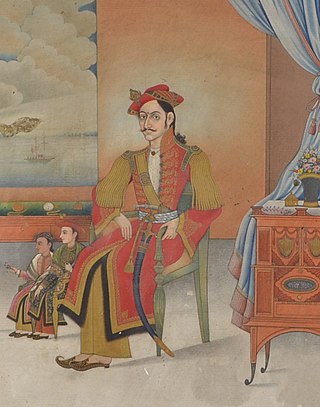
The Kingdom of Nepal was a Hindu kingdom in South Asia, formed in 1768 by the expansion of Gorkha Kingdom, which lasted until 2008 when the kingdom became the Federal Democratic Republic of Nepal. It was also known as the Gorkha Empire, or sometimes Asal Hindustan. Founded by King Prithvi Narayan Shah, a Gorkha monarch who claimed to be of Khas Thakuri origin, it existed for 240 years until the abolition of the Nepalese monarchy in 2008. During this period, Nepal was formally under the rule of the Shah dynasty, which exercised varying degrees of power during the kingdom's existence.

Maharajadhiraj Prithvi Narayan Shah (1723–1775) was the last ruler of the Gorkha Kingdom and first monarch of the Kingdom of Nepal. Prithvi Narayan Shah started the unification of Nepal.

The Anglo-Nepalese War, also known as the Gorkha War, was fought between the Gorkhali army of the Kingdom of Nepal and the British forces of the East India Company. Both sides had ambitious expansion plans for the mountainous north of the Indian Subcontinent. The war ended with the signing of the Sugauli Treaty in 1816, which ceded some of the Nepalese-controlled territory to the EIC.

The Gorkha Kingdom was a member of the Chaubisi rajya, a confederation of 24 states on the Indian subcontinent ruled by the Khas people. In 1743 CE, the kingdom began a campaign of military expansion, annexing several neighbors and becoming present-day Nepal. The Gorkha Kingdom extended to the Marshyangdi River in the west, forming its border with the Kingdom of Lamjung. To the east, the kingdom extended to the Trishuli River, forming its border with the Nepal Mandala. The Gorkha Kingdom was established in 1559 CE by Prince Dravya Shah, second son of King Yasho Brahma Shah of Lamjung. The prince replaced the Khadka chiefs who previously ruled the region.

Amar Singh Thapa Chhetri distinguished as Badakaji Amar Singh Thapa(Nepali: बडाकाजी अमर सिंह थापा क्षेत्री), or Amar Singh Thapa The Elder, also known by the honorific name Bada Kaji or Budha Kaji, was a Gorkhali military general, governor and warlord in the Kingdom of Nepal. He was the overall commander of the Nepal Army in the conquest of Western Provinces and authoritative ruler of Kumaon, Garhwal in the Kingdom of Nepal. He was referred by the King of Nepal to have been deployed as Mukhtiyar of Western Provinces of Kumaon, Garhwal He is often hailed as Living Tiger of Nepal and he was posthumously regarded as one of the national heroes of Nepal, who led the Anglo-Nepalese War for the Gorkhali Army. Amarsingh Chowk Pokhara and Shree Amarsingh Model Higher Secondary School are named after the name of Amar Singh Thapa.

The Shah dynasty, also known as the Shahs of Gorkha or the Royal House of Gorkha, was the ruling Chaubise Thakuri dynasty ; and the founder of Gorkha Kingdom from 1559 to 1768 and later the unified Kingdom of Nepal from 1768 to 28 May 2008.

The unification of Nepal was the process of building the modern Nepalese state, from fractured petty kingdoms including the Baise Rajya and the Chaubisi Rajya, which began in 1743 AD. The prominent figure of the unification campaign was Prithvi Narayan Shah, King of Gorkha. On 25 September 1768, he officially announced creation of the Kingdom of Nepal and moved his capital from Gorkha to the city of Kathmandu.

Basnyat/Basnet family or Basnyat/Basnet dynasty was a Khas-Chhetri and a warlord clan family involved in the politics and administration of the Gorkha Kingdom and Kingdom of Nepal. This family got entry into Thar Ghar aristocracy group of Gorkha at the time of King Prithvi Narayan Shah. It was one of the four noble families to be involved in active politics of Nepal together with Shah dynasty, Pande family and Thapa dynasty before the rise of Rana dynasty. This family is descended from Shivaram Singh Basnyat, the commander of Gorkhali forces and a member of Shreepali Basnyat clan of Gorkha. This family was maritally linked to Kala (Black) Pande section of Pande dynasty through Chitravati Pande who married Kaji Kehar Singh Basnyat. This family was the last Kshatriya (Chhetri) political family to be wiped out from the central power by Jung Bahadur Rana of Kunwar family during the Bhandarkhal Massacre in 1846 for the conspiracy to take the power leading to people suffering from the Rana rule for 104 long years.
Limbuwan is an area of the Himalayan region historically made up of 10 Limbu kingdoms, now part of eastern Nepal. Limbuwan means "abode of the Limbus" or "Land of the Limbus".Limbuwan was incorporated to the Kingdom of Nepal by the means of collective Gorkha-Limbuwan Treaty with the kings of ten kingdoms of Limbuwan and their ministers.
History of Limbuwan is characterized by the close interaction of Limbuwan with its neighbours independent and semi-independent rule characterized by autonomy for most of its time.

Liglig, better known as "ligligkot" is a hill top located in Palungtar Municipality of Gorkha, Nepal. It is located at the height of 1437 meters (4790 feet) mean sea level. Gorkha District has a long and intriguing history. It’s where a royal dynasty got its start and the famous Gurkha soldiers got their name. Located 80 kilometers (50 mi) due west of Kathmandu. It is the place where the former monarchy of Nepal was established.

Sindhuli Gadhi is an historical fort and tourist attraction in central Nepal. Sindhuli Gadhi is famous for the battle between the then Gorkha Army and the British troop headed by Captain Kinloch. The Gorkha force under the command of Khajanchi Bir Bhadra Upadhyay and Sardar Banshu Gurung defeated the British troop in November 1767.

Chandrabhoga Gadhi is a historical ruins fort located in Shambhunath, Saptari District, Nepal. The ruins fort is located in the Rupani- Shambhunath Chure hill section north west of Kanakpatti village around 4 km. The hill fort was originally built by the Senas of Makwanpur in the 15th century. The temple of Chandrabhoga- clan deity of Sena was built by 27th Sena King Chandrasen. The fort is locally known as Chanarbhoga Gadhi and is believed to be the remnants of the Ekagarh, the palace of Sen Kings during winter season.
Bakhtawar Singh Thapa also spelled Bhaktawar, was a Nepalese military commander, politician, and governor. He acted as an aide of his brother Mukhtiyar Bhimsen Thapa and was appointed the commander of Samar Jung Company. He commanded the Bijayapur-Sindhuli Gadhi Axis in the first campaign of Anglo-Nepalese War and Makwanpur Gadhi Axis in the second campaign. Later, he became the governor of Palpa and died in the office.

Ram Krishna Kunwar or Ramakrishna Kunwar was military commander (Sardar) of Gorkha Kingdom during the Unification of Nepal at the reign of King Prithvi Narayan Shah. He was born circa 1728 AD to Ashiram Kunwar in the Kunwar family. His descendants went on to found the Rana dynasty of Nepal. He was a successful general in the unification campaign of Nepal of King Prithvi Narayan Shah. He defeated British forces at Hariharpur Gadhi on 25 August 1767. He died in Mechi Campaign in 1771 A.D.

Vamsharaj Pande was a Nepalese politician, military officer and minister of state. He was a significant army commander of Kingdom of Nepal in the second half of 18th century. He was a follower of Bahadur Shah of Nepal and had a significant rivalry with Swaroop Singh Karki.

Ranabir Singh Thapa also spelled Ranbir, Ranavir or Ranvir also known by the late ascetic name Swami Abhayananda was a Nepalese Army General, prominent politician and minister of state. In 1837, he became Acting Mukhtiyar of Nepal for a brief period. He was a prominent member of Thapa dynasty. He later turned ascetic and was known by the Sanyasi name Swami Abhayananda.

Thapa dynasty or Thapa noble family was a Kshatriya political family that handled Nepali administration affairs between 1806 and 1837 A.D. and 1843 to 1845 A.D. as Mukhtiyar. This was one of the four noble families to be involved in the active politics of the Kingdom of Nepal, along with the Shah dynasty, Basnyat family, and the Pande dynasty before the rise of the Rana dynastyor Kunwar family. At the end of 18th century, Thapas had extreme dominance over Nepalese Darbar politics alternatively contesting for central power against the Pande family. Bir Bhadra Thapa was a Thapa of Chhetri group and leading Bharadar during Unification of Nepal. His grandson Bhimsen Thapa became Mukhtiyar of Nepal and established Thapa dynasty to the dominating position of central court politics of Nepal.

The Chisapani Gadhi is a fort in Bhimphedi, Makwanpur that was built around 1744–1745 AD. The fort was controlled by the Sen Dynasty but after the Gorkha Kingdom captured Makwanpur they used the fort for the military, administrative, trade and immigration purposes. King Prithvi Narayan Shah used it to create an economic blockade to the Kathmandu Valley. According to historians, the fort had a court, a check post, and an office for a local governor. During the Anglo-Nepalese War, commander Ranabir Singh Thapa deployed many soldiers inside the fort. But the forces did not directly face the East India Company. Thapa at the Makwanpur Gadhi stopped the Company troops from getting into the fort, and they subsequently went moved to capture the Sim Bhanjyang instead.
















